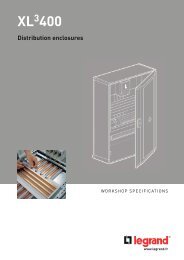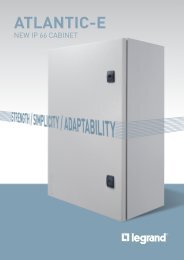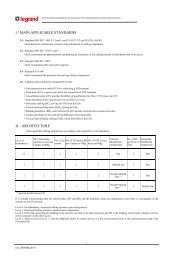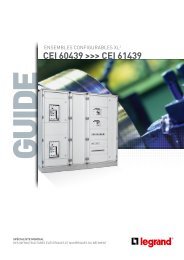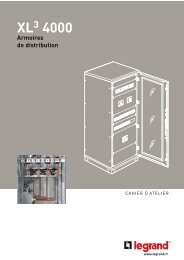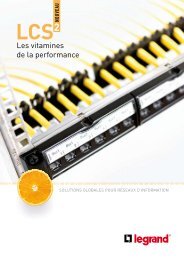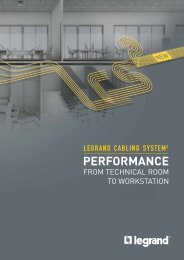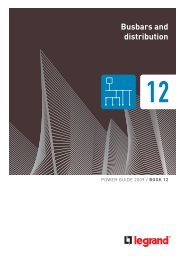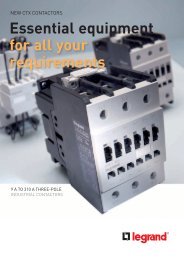Download - legrand
Download - legrand
Download - legrand
You also want an ePaper? Increase the reach of your titles
YUMPU automatically turns print PDFs into web optimized ePapers that Google loves.
Capacitor banks (continued)<br />
BUILT-IN ELECTRICAL PROTECTION DEVICES<br />
MEDIUM VOLTAGE RANGE<br />
In addition to the protection devices specific to each<br />
capacitor (internal fuses or pressure monitoring<br />
devices), other accessories must be used and an<br />
associated external protection device incorporated in<br />
the capacitor bank. The most commonly used external<br />
protection devices are:<br />
- HRC fuses<br />
- Unbalance or differential protection<br />
HRC fuses<br />
Protection using HRC fuses integrated in the capacitor<br />
bank is ideal (technically and economically) for<br />
capacitor banks with the following characteristics:<br />
- Low power (< 1000 kVAr)<br />
- Those equipped with three-phase connection<br />
capacitors (see delta wiring, p. 57)<br />
- Supply voltage less than 12 kV<br />
The rating of the HRC fuses will be selected to have a<br />
value between 1.7 and 2.2 times the nominal current of<br />
the capacitor bank.<br />
HRC fuse blow-outs are generally caused by a short<br />
circuit inside the capacitor.<br />
Unbalance or differential protection<br />
This protection generally applies to capacitor banks<br />
with the following characteristics:<br />
- Medium or high power (> 1000 kVAr)<br />
- Those with single phase connection capacitors<br />
- Supply voltage greater than 12 kV<br />
Unbalance or differential protection is sensitive,<br />
capable of detecting and reacting to a partial fault in a<br />
capacitor.<br />
It consists of a current transformer connected between<br />
two electrically balanced points, combined with a<br />
current relay. When there is a fault in a capacitor there<br />
is an unbalance and therefore a current circulating in<br />
the current transformer, which will cause, by means of<br />
the relay, the banks' operating device (circuit breaker,<br />
switch, contactor, etc.) to open.<br />
ADDITIONAL ACCESSORIES<br />
Quick discharge reactors<br />
Installing two quick discharge reactors or voltage<br />
transformers between the phases of the capacitor bank<br />
reduces the capacitor discharge time from 10 minutes<br />
to approximately 10 seconds.<br />
This reduced discharge time:<br />
- Provides safety for staff when carrying out work<br />
- Reduces waiting time before earthing (closing of the<br />
earthing switch)<br />
- Makes it possible to reactivate the capacitor banks<br />
in steps more quickly after breaking, although a<br />
minimum time of 30 minutes between two discharges<br />
is essential, to ensure correct cooling of the reactors.<br />
Damping reactors<br />
Installing single phase damping reactors in series on<br />
each phase of the capacitor bank makes it possible<br />
to reduce the switching currents to values that are<br />
acceptable for the corresponding operating device.<br />
These are necessary in the following situations:<br />
- Step capacitor banks<br />
- Very high mains short-circuit power in relation to the<br />
power of the capacitor bank to be connected<br />
- Frequent control operations of the capacitor bank<br />
62



